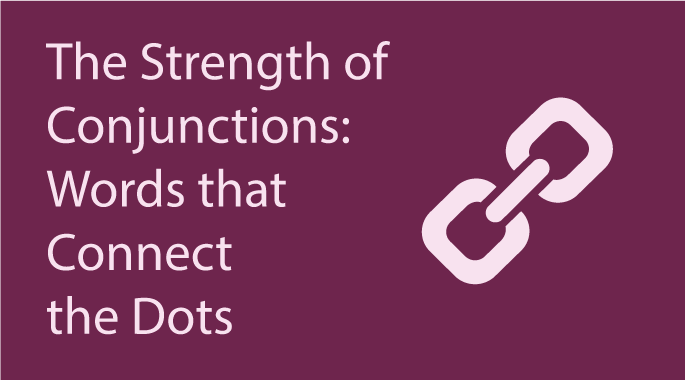
Have you ever wondered how sentences stick together? That’s where conjunctions or connecting words come in! They’re like magic words that connect other words or groups of words, making everything make sense.
Table of Contents
What are conjunctions?
Conjunctions or connecting words or Connectors are words that connect words, phrases, or clauses. They help us to create more complex and nuanced sentences, and they play an important role in expressing relationships between ideas.
Types of Connectors
There are four main types of conjunctions: coordinating, subordinating, and correlative.
1. Coordinating Connectors
Coordinating conjunctions connect words, phrases, or clauses of equal grammatical rank. They are often used to show addition, contrast, or choice. Some of them include:
- for
- and
- nor
- but
- or
- yet
- so
2. Subordinating Connectors
Subordinating conjunctions introduce subordinate clauses, which are clauses that depend on independent clauses for their meaning. Subordinating connecting words show the relationship between the subordinate clause and the independent clause. Some of them include:
- because
- although
- if
- when
- since
- as
- unless
Correlative Connectors
Correlative conjunctions connect words or phrases that are balanced or paired. They are often used to show contrast or emphasis. Some common correlative conjunctions include:
- either/or
- neither/nor
- both/and
- not only/but also
- whether/or
4. Conjunctive Adverbs
Conjunctive Adverbs Think of these as the smooth operators of sentences. They help them flow smoothly from one idea to the next. ‘However,’ ‘therefore,’ and ‘meanwhile’ are a few examples. They’re like traffic signs that guide the flow of ideas.
Examples of Connectors in use
Here are some examples of how conjunctions are used in sentences:
- I went to the store and bought some groceries. (Coordinating conj.)
- I didn’t go to the party because I was feeling sick. (Subordinating conj.)
- You should either study for the exam or accept the consequences. (Correlative conj.)
The importance of conjunction
Next time you write or read, keep an eye out for these tiny yet powerful words. They’re the magic bits that turn words into sentences, sentences into stories, and stories into adventures! So, join the fun, learn about these mighty connectors, and watch how they turn simple words into incredible stories. Happy writing and reading!
Frequently Asked Questions (FAQs)
1. What is a conjunction?
- A conjunction or a connecting word is a word that connects words, phrases, or clauses in a sentence. It’s like a link that joins different parts of a sentence together.
2. What are the different types of connecting words?
- There are three main types: coordinating, subordinating, and conjunctive. Coordinating connecting words, like ‘and’ or ‘but,’ connect equal parts. Subordinating conjunctions, such as ‘if’ or ‘because,’ link unequal parts, highlighting the more important one. Conjunctive adverbs, like ‘however’ or ‘therefore,’ work as transitions between ideas.
3. How do a conjunction makes sentences better?
- conjunctions help create more complex and interesting sentences. They make the relationship between words or ideas clearer and ensure the flow of the sentence is smooth and logical.
4. Can I start a sentence with a conjunction?
- Traditionally, starting a sentence with a connecting word was frowned upon in formal writing. However, in modern usage, it’s more acceptable in informal or creative writing to start a sentence with a conjunction to add emphasis or stylistic flair.
5. How can I identify connecting words in a sentence?
- Look for words that connect phrases or words together. Words like ‘and,’ ‘but,’ ‘or,’ ‘because,’ ‘although,’ ‘however,’ and ‘while’ are examples of connecting words.
6. What happens if a sentence doesn’t have a conjunction?
- Without a connecting word, sentences can feel short, abrupt, or less connected. connecting words help provide clarity and coherence in expressing ideas within a sentence.
7. Can I use multiple connectors in a single sentence?
- Yes, you can use multiple connecting words in a sentence, depending on the complexity of the relationships you’re trying to express. However, overusing connecting words might make a sentence seem cluttered, so it’s important to find a balance.
8. Are connecting words only used in English?
- No, they are found in many languages across the world. Different languages might have their own specific connecting words and rules for how they are used, but the basic function of joining words or clauses remains the same.
9. Can a single word be both a connecting word and another part of speech?
- Some words can serve as both a connecting word and another part of speech. For instance, the word ‘that’ can be a subordinating conjunction or a pronoun.
10. How can I improve my use of connecting words in writing?
- Practice using a variety of connecting words to connect ideas more effectively. Reading extensively can also help you understand how they are used in different contexts. Experiment with sentence structures to see how they alter the flow and meaning of your sentences.
Read a a full list of grammar topics for better understanding of English grammar.